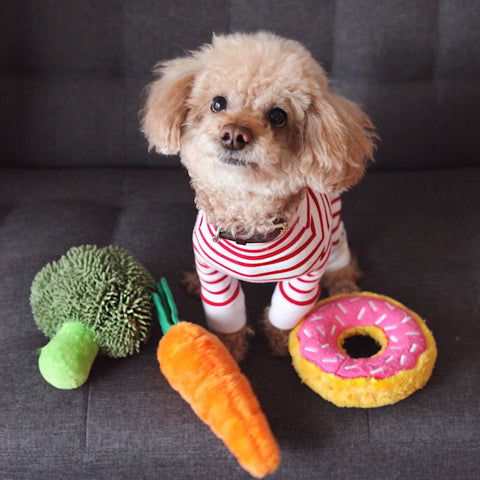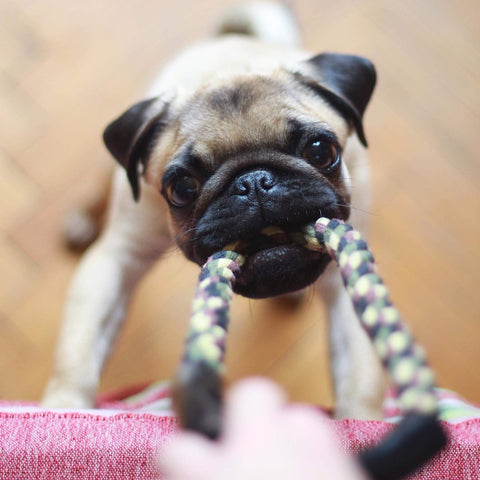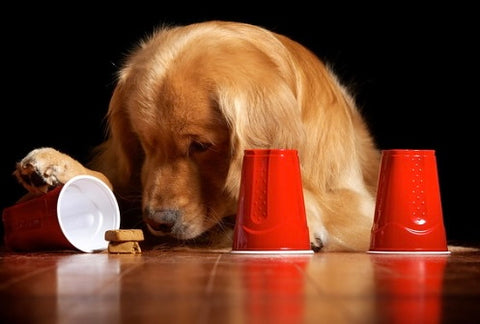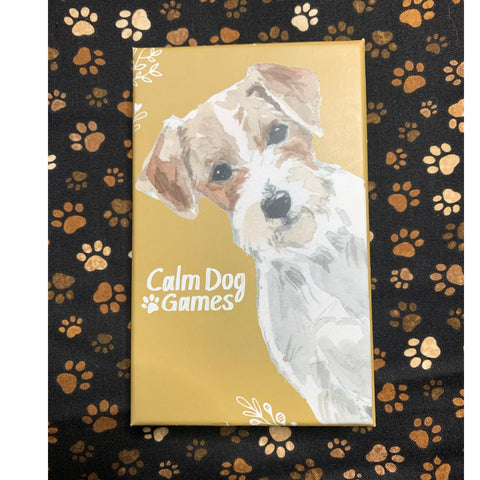Ten indoor games for reactive dogs and rainy days.
Ten indoor games for reactive dogs and rainy days.
There are lots of exciting activities that you can get involved in when you have a dog.
You could consider joining in with agility classes, heelwork to music or flyball.
If you are super active you might consider canicross, dog parkour or bikejor.
When you have an anxious or reactive dog it can be a real challenge to exercise them outdoors or in group settings as they find it stressful and may be unable to tolerate being around other dogs.
Leo our Labrador is an anxious and reactive dog, so we walk early mornings and late in the evening mainly because he refuses to toilet in the garden. He also has a spinal problem which limits the type and amount of exercise he can have.
He has a potter round the garden in an afternoon but it is such a boring activity for him and for me. So I did some research to see how I could make his afternoons more fun and discovered there are lots of things you can do to enrich your dog’s life indoors and in the garden.
So here are ten fun activities you can you do with your dog at home without spending a fortune on

1. Play a game of ‘Find The Treats’.
Scent work games are an easy way to tire out your dog. If you can teach your dog some basic ‘scent games’ such as ‘find the treats’ you’re helping them concentrate on some of their natural skills whilst mentally tiring them out.
To play all you have to do is take some of their favourite treats and have your dog sit and watch as you place them around the room. Give your dog the cue to’find’ the treats and encourage your dog to pick them up. Always remember to praise them every time they find one.
Once you are confident that your dog understands what “find ” means you can making it a bit more challenging. Get them to sit in another room whilst you hide the treats, maybe behind a cushion, under a rug, toy or slipper.
You don’t need to use expensive shop bought treats, you could try tiny pieces of cheese or have a go at making your own treats at home.
If you have an anxious dog you could use a cardboard box filled with safe and clean recycling packets and plastic botles and scatter some of your dog’s daily food allowance in there. The items in the box will move in unexpected waays and may make a noise whilst your dog hunts for their food. This is particularly helpful for anxious dogs as it helps to build their confidence and

2. Use a stuffed Kong or Licky mat to keep your dog
Dogs were bred to work with us, so nowadays our beloved family pet is missing out on the mental stimulation that comes with work. Dogs are scavengers, so having to work for food is normal for them. One of the easiest ways to challenge your dog’s brain is to make them work for their food. You can use their daily rations for training or they can eat from a food dispensing toy.
Licky mats and stuffed Kongs can be really useful to help to relieve dog boredom and they are so easy to prepare. To keep your dog busy for a while you could try stuffing a Kong with some of their favorite treats or you could freeze some peanut butter or bone broth inside. This will give your dog something to work for. If you don’t know what use check out the Kong website where they share recipes you can make at home.
A frozen Kong should last 30 minutes or more for most dogs sometimes much longer if you fill it right up. They are easy to clean and are dishwasher safe.
We have a couple of Kongs and a West Paw Toppl toy which works equally well.

3. Teach your dog the names of their toys.
Some dog can learn hundreds of words but they don’t need to be a canine mastermind to learn the names of a few of their toys. Once they do you can use this skill to play some fun games.
Start by playing with a particular toy and giving it a name. After some practice & praise your dog will associate that name with the chosen toy. Once your dog has learned a particular toy’s name you can test out their skills by asking them to pick it out from a pile of their other toys. You can repeat this with other toys as they increase their knowledge and memory.
4. Teach your dog to “Find” their toys.
You can build on the previous game once your dog knows the names of some of their toys. Using these toys you can teach them the “go find it” game.
Put your dog’s toys in a pile or in a box and tell them to ‘find’ their favorite toy. As your dog gets better at this you can make it more difficult by increasing the number of toys they have have to search through.
Make sure that it is fun for them by rewarding them with a treat or maybe a quick tug game when they succeed. This game should give your dog a great mental workout which helps to tire them.

5. Play a Game of Tug.
According to many sources playing tug is one of the best games to play with our dogs as it provides mental and physical stimulation. You can play it indoors or in the garden and even take a pocket sized tug out on walks with you.
Tug can help to train impulse control, build confidence, and strengthen the bond between you and your dog. This activity taps into your dog’s natural prey drive, which makes it a motivational, reinforcing, and high-value training tool too which can really help with obedience, recall and improves the dog / owner bond.
At the end of this blog there are some simple guidelines for playing tug safely with your dog which you can save and print out if you need to. Check out our new snuffle balls and tug toys.

6. Play puzzle games.
To keep your dog busy on rainy days you could try interactive games such as fetch, puzzle games which keep your dog mentally stimulated which can help cut down on problem behaviors like excessive chewing or barking.
Ideas for puzzle games
- Hide and seek. You hide they seek!
- Fetch. Use a lightweight ball indoors.
- Treat dispensing toys. Check out the Kong Rewards Ball or Kong Wobbler. Add a few treats and watch your dog work out how to make them fall out of the hole. (Charley plays with hers for ages!) Snuffle mats and balls work well too.
- Treats rolled in a towel. Take a small towel, scatter some treats on top and then roll it up tightly. Then sit back and watch your dog work out how to unroll the towel.
- Muffin tin game. Take a 6 hole muffin tim and put a treat in each recess. Cover each with a ball or a rolled up sock and let your dog work out how to get at their favourite treats.
- Make a ball pit. If you have a paddling pool fill it with cheap ball pit balls instead of water and then sprinkle some kibble in it to make your dog work for their food.

7. Play the Cup Game
This simple game gives your dog plenty of mental stimulation, and helps them develop problem solving skills. To play the cup game let your dog watch as you place one of their favourite treats under one of three cups. You then shuffle the cups around and encourage them to ‘find the treat.’ Their reward is the treat once they identify the right cup and win their treat

8. Bubble chasing can be fun.
Bubble chasing is a simple way to keep any dog entertained, happy and active.
Many dogs are fascinated by bubbles, very much in the way children are. You can use child safe bubble mix as it is non-toxic but do investigate some of the pet bubbles which are available in bacon, peanut butter and beef flavours.

9. Create an indoor or garden obstacle course.
You can create an obstacle course using household items like towels and cushions. Encourage your dog to jump over things, lie on things and balance on things for a mini home based parkour session. You could get then to weave around toys or cardboard boxes. All you need is a bit of imagination, introducing one move at a time until your dog is proficient at getting around. This game can improve concentration and focus.

10. Massage and grooming.
After all this stimulating activity what could be better than a bit of down time brushing, grooming or massaging your dog. These activities can be relaxing and enriching for you both as they increase trust and strengthen the bond between you.
There are lots of different techniques that can be used for canine massage so it is a good idea check out the different ways by looking at online guidance before you start. Extra care needs to be taken with older and arthritic dogs.
More inspiration
Once you have tried the ideas in this blog you can find more inspiration from a couple of brilliant sources that I found whilst doing my research.
If you want to spend more time playing with your dog, check out all the ideas from Niki French at Pup Talk. She has written a book about games you can play when you either can’t walk your dog or don’t want to walk your dog because they are reactive. She specialises in training and games that you can do at home. She has a fabulous free Facebook group and has written a brilliant book called Stop Walking Your Dog.

You might also want to invest in a pack of games cards from Calm Dog Games. It’s just like a pack of playing cards but these cards contain 52 games you can play to increase your dog’s mental stimulation. There are 5 categories which include activities for play, improving focus, puzzles, calmness and bonding.
If your dog loves to tug here are some simple tips to make sure you both stay safe and the activity is as rewarding as possible for your dog.
Guide lines for playing tug games safely.
A game of tug is a lot of fun for dogs, and it’s a great way to increase your dog’s manners. It is a brilliant game to play anytime, anywhere and will help to teach them obedience, bite inhibition and impulse control. It is a myth that playing tug can make dogs aggressive, nor will it make them dominant if you let them win, in fact it is a very good way to teach them self control. Playing tug with your dog will also strengthen your bond with them.
It’s also a pretty good workout for them too and can be one of the more physically demanding games we play with them. Just a few minutes can be enough to get most pups tired out.
A big bonus is that you can play just as well indoors as you can outdoors, so you can make sure your dog is well-exercised even on wet and rainy days.
Another brilliant benefit of tug is that it builds confidence. So for people who have a shy and anxious dog, playing a short session in a scary new place or when new visitors come in the house can help to make your dog feel much more comfortable.
How to play tug safely whilst maximizing the benefits.
- Be gentle: You should always use tug toys with caution. – don’t yank or swing the tug up and down when your dog has locked its teeth onto it as this is not a natural movement and it can damage the spine. Let your dog do the work and watch how they move naturally. You should never pull harder than your dog is pulling.
- Puppies: Be even more cautious when playing with puppies as their teeth and jaw is still developing and you can cause serious harm if you don’t play gently.
- Tug time: You should let your dog pull on the tug for between 10 to 20 seconds for each session.
- Let your dog win: By letting your dog “win” during tug sessions you are actively engaging with them and giving them the chance to share “their property”. This is an important part of the bonding process and helps establish boundaries when the dog chooses to bring the toy back to you.
- You should initiate the game - not your dog: You should always be the one who starts the tug game as this puts you in control. When the tug toy is not in use, make sure you store it where the dog can’t get it. This is doubly important if you have more than one dog - you don’t want them starting a game with each other!
- Only use one tug toy: It is best to have a special tug toy and use it every time you play. This creates a boundary of what is a toy and what isn’t. This should help to prevent your dog from trying to play tug with things they find, such as socks, clothes or blankets.
- Use a ‘Drop it’ command: Like any activity with your dog, they should be able to obey basic commands first. This will ensure the safety of you, your dog and others. If your dog can drop the toy when told then you are able to de-escalate the game if it’s getting out of hand. By getting your dog to drop the tug during an active play session is also a great training tool for when you need them to drop an item they shouldn’t have.
- Check out your surroundings: Before you start make sure there is plenty of space so you or your dog can’t bump into anything. Consider the flooring as well. Laminate, wood or tile floors can be slippery and during a vigorous game of tug accidents can happen, so you might want to play outdoors on grass or on the carpet.
How to play
- Shake the tug toy vigorously and tell your dog to "get it!"
- Once they have latched on, continue to tug for 20-30 seconds. Get your dog excited by raising the volume and tone of your voice.
- Let the toy go limp in your hand and tell your dog to "drop it" and wait for the dog to release. It's important that you neither let go, nor continue to pull; just hold it firmly without tugging and wait. It may take a few seconds, or maybe even whole minute before your dog "drops it".
- Once they let it go, praise enthusiastically and immediately jump back into the excitement of the game.
- The game must stop if their teeth touch your hand.
- Be prepared to end the game if your dog is over stimulated.
- End the game by providing a treat after the "drop it," then saying "all done" and putting the tug toy away.
- The game eventually becomes its own reward, and it really can enhance your bond with your dog.
Advanced tug tips
- As your dog gets the hang of it, and they drop the toy consistently, start waiting for your dog to sit before playing the game again.
- Keep the tug toy out of reach at all times and only bringing it out when it's time to play. That gives the game an even more special meaning and your dog will look forward to that awesome play session every time you bring the toy out increasing the value of the game.

If you enjoyed reading about these activities and games do check out Pup Talk and Calm Dog Games for more ideas.
